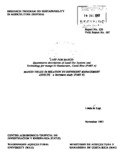| dc.description.abstract | The research described in this thesis was conducted within the Atlantic Zone Project (AZP) in Costa Rica in 1995. The program developed the USTED (Uso Sostenible de Tierras en el Desarrollo Sustainable Land Use in Development) Methodology (Stoorvogel et al., 1995) which supports regional land use planning agricultural lands. The approach followed by the AZP uses the term LUST (Land Use System and Technology). This form of describing land use includes a quantification of the technology. The objective of this study was to describe activities in the production of mango (Mangifera indica) in Guanacaste and to quantify the corresponding inputs and outputs. The aim was to describe at least two LUSTs, based on a cluster analysis of the data. The required data were gathered by doing a questionnaire among twenty-four mango cultivators in the study area. Data were gathered about general aspects of the plantation (such as area and age of the plantation), sowing, irrigation, weeding, pruning, flower induction, fertilization, harvesting and controlling pests and diseases. Of all these aspects, data about hours of labour, time of the year, equipment used, products used and amount of inputs had to be gathered. These were necessary for describing LUSTs. A statistical cluster analysis (Ward method) was used to make four groups of mango plantations which each represent a LUST. The group with the most extensive management consists of five fields and was given number one in the cluster analysis. The group with number two is less extensive than cluster one. Sometimes the fields are a bit neglected, but occasionally the management is quite intensive without, for instance, intensive irrigation. Often capital is lacking. Fields that are in group three have intensive management and belong to the largest cluster. Fields with number four have the most intensive management. There are only three cases of this category in this study and they all belong to the same company. In general, it becomes clear that the acreage increases per cluster. Cluster one has an average of 10 hectares, cluster two of 29 hectares, cluster three of 41 hectares and cluster four of 473 hectares. Cluster one contains the only farMON with varieties that are only suitable for the local market and there is hardly any flower induction or irrigation. In the other clusters, there is always flower induction and from cluster two to four, the type of irrigation becomes more capital intensive. | es_ES |


